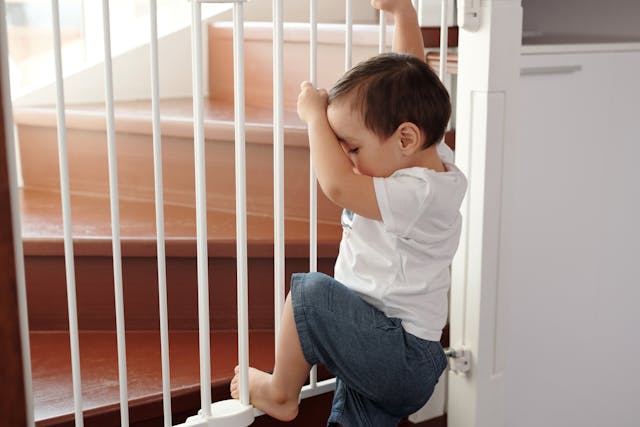Creating a safe home is always a great idea. However, once you have littles that can start exploring, the environment for children is one of the most important responsibilities of parenting. As little ones explore their surroundings, they encounter numerous potential hazards that can lead to accidents.

Conduct a Safety Audit
Identify Potential Hazards
The first step in ensuring a safe home is to conduct a thorough safety audit. Walk through your home with a keen eye, looking for potential dangers in each room. Common hazards include sharp objects, toxic substances, and choking hazards. Pay special attention to the kitchen, bathroom, and living areas where children often play and explore.
In the kitchen, consider the risks associated with knives, hot surfaces, and small appliances. In bathrooms, watch for slippery floors, medications, and cleaning supplies. In living areas, look out for loose cables, small items that can be swallowed, and heavy furniture that can tip over. Identifying these hazards will help you take the necessary steps to mitigate risks.
Get Down to Their Level
To spot hazards effectively, it can be helpful to get down to your child’s level. This means kneeling or sitting on the floor to see the environment from their perspective. By doing so, you may discover hidden dangers that you wouldn’t notice from an adult’s viewpoint. Look for items within reach that could be dangerous, such as electrical cords, sharp corners, and items on shelves that could fall.
Secure Furniture and Appliances
Anchor Heavy Furniture
One of the significant safety concerns in homes with young children is the risk of furniture tipping over. Heavy items like bookshelves, dressers, and televisions can pose a danger if a child tries to climb or pull on them. To prevent this, anchor these pieces of furniture to the wall using safety straps or brackets.
A Cincinnati premises liability attorney emphasizes the importance of taking such precautions to avoid potential accidents that could lead to injuries. They remind homeowners that failing to secure heavy furniture can lead to serious consequences, especially if a child is injured due to negligence in safety measures.
Childproof Cabinets and Drawers
Curious little hands are often drawn to cabinets and drawers where hazardous items may be stored. To keep your child safe, invest in childproof locks or latches for accessible storage spaces. This applies to kitchen cabinets containing cleaning supplies and sharp utensils, as well as bathroom cabinets housing medications and personal care items.
By making these areas off-limits, you can help prevent accidents and keep dangerous substances out of reach.
Create a Safe Play Area
Designate a Play Zone
Setting up a designated play area can help minimize risks associated with playtime. Choose a specific room or corner of a room where your child can play freely without the hazards of other household activities. Keep this area clutter-free and ensure it’s stocked with safe, age-appropriate toys.
Use furniture to create boundaries, making it easier for little ones to understand their play space. This not only helps with safety but also promotes imaginative play.
Use Soft Surfaces
Incorporating soft surfaces in your play area can cushion falls and minimize injuries. Consider using area rugs, foam mats, or carpets to provide a safer environment for your child to explore. These materials can help absorb the impact if a child trips or falls while playing, making them an essential addition to any play space.
Manage Electrical Safety
Cover Outlets
Electrical outlets are a common source of danger for young children. To prevent electrical shocks, use outlet covers or safety plugs. These devices are simple to install and create an extra barrier between your child and the potential hazards posed by electrical outlets.
Keep Cords and Wires Tidy
Loose cords and wires can pose a strangulation risk and create tripping hazards. To keep them organized, use cord management solutions like clips or ties to secure them out of reach. Consider using cord covers to hide any exposed wires that may be tempting for little hands to grab.
Ensure Bathroom Safety
Non-slip Mats and Grips
Bathrooms can be slippery places, especially when wet. To reduce the risk of falls, use non-slip mats in the tub and on bathroom floors. These mats provide extra traction and help keep your child stable while bathing. Additionally, consider installing grab bars in the shower or tub area for added support.
Store Medications and Cleaning Supplies Safely
Medications, cleaning supplies, and personal care items should always be stored out of reach or locked away. Even if you think your child knows not to touch these items, it’s essential to be proactive. Invest in high cabinets or use childproof locks to ensure that potentially dangerous substances are inaccessible.
Implement Kitchen Safety Measures
Use Stove Guards
The kitchen can be one of the most hazardous places for little ones. To prevent burns and accidents, use stove guards to keep your child away from hot surfaces and cooking areas. These guards create a physical barrier, helping to ensure that your child stays safe while you prepare meals.
Store Knives and Sharp Objects Safely
Ensure that knives and sharp kitchen tools are stored out of reach or in locked drawers. Consider using knife blocks with safety features or magnetic strips mounted high on the wall. This simple measure helps prevent accidental cuts and injuries while fostering a safer kitchen environment.
















Add Your Comment